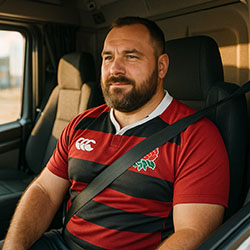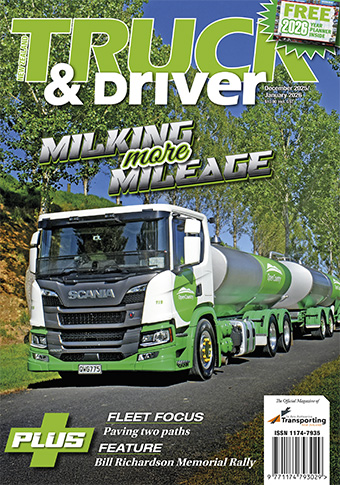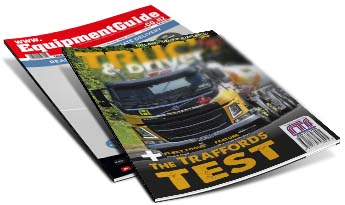
Buckling The Trend - Rugby Stripes Become Road Safety Wake-Up Call
Posted: 02-Oct-2025 |
In a first for New Zealand rugby, traditional jerseys have been modified to carry a road safety message – with traditional rugby stripes turned into seatbelts to encourage people to buckle up for those they love.
NZ Transport Agency Waka Kotahi (NZTA) has partnered with the Northland and Canterbury Rugby Unions to launch a seatbelt campaign targeting fans.
“Wearing a seatbelt is one of the easiest, fastest and most effective ways to protect yourself from injury in a crash. It reduces the risk of dying or being seriously injured by 40%,” says Tara MacMillan, NZTA’s Head of Regulatory Strategic Programmes.
“It’s about protecting yourself, your whānau and your mates. If everyone buckled up, we could save around 20 lives every year.”
On Sunday 28 September at Semenoff Stadium in Whangārei, Northland and Canterbury players took to the field in in special edition jerseys where the traditional horizontally placed stripes or “hoops” have been rotated diagonally across the chest, turning a long-standing symbol of rugby into a road safety reminder.
“Rugby is the heartbeat of so many of rural communities, so taking the message to grassroots rugby means we’re targeting the group least likely to use seatbelts – men aged 18–39 living in rural communities – through the clubs and communities they are part of,” Ms MacMillan says.
Seatbelts have been compulsory in New Zealand since the 1970s, yet compliance remains an issue. Since 2020, 447 people killed in crashes were unrestrained – 34% of all road deaths. In Northland, that figure rises to 45% (61 people); in Canterbury, 31% (52 people).
Northland Rugby CEO Paul Lennane says; “The numbers show how hard Northland has been hit by road deaths when seatbelts weren’t worn. Our clubs are the centre of our communities, and when one person is lost, we all feel it. If these jerseys could prompt just one more person to buckle up, that’s enough for us. We hope both fans and the community will take notice of this important message.”
Stripes and hoops have been part of New Zealand rugby since the 19th century, when they were first used to differentiate teams before numbered jerseys were introduced. Over time, they became closely tied to provincial identity – from Northland’s Cambridge blue and white hoops to Canterbury’s red and black stripes, worn for 146 years. By adapting these hoops into seatbelts, the campaign uses one of rugby’s oldest traditions to reinforce the important safety message.
Canterbury Head Coach, Marty Bourke says; “The team is honoured to be able to wear these special edition jerseys, in the hopes that it will remind people of the importance of buckling up every drive. It’s also great to know that beyond game day, they’ll be hanging in community club rooms around Canterbury and Northland to keep this issue top of mind.”
Seatbelts support you in a crash or when the vehicle stops suddenly. Without a seatbelt, front seat occupants can be thrown through the windscreen and onto the road. Back seat passengers can be thrown onto the front seats or the front seat passengers or can hit the roof.
This initiative is part of the NZTA’s National Road Safety Promotion Programme, which delivers education and awareness campaigns to reduce harm on New Zealand roads. It focuses on two messages: ‘Who do you wear it for?’ – encouraging people to think about those who would be left behind – and ‘Buckle up every drive’ reminding people that it doesn't matter how small a trip may be - wearing a seatbelt is something you should never skip.
85% of New Zealanders understand that in a crash seatbelts can save lives or limit the severity of an injury. However, research shows that some people are still not doing it.
The data shows that the group least likely to wear belts are males aged 18-39 who live in rural regions. A large proportion of them haven’t got their full licence and haven’t progressed through the graduated driver licensing system and have limited awareness of existing seatbelt or safety messages.
There are a variety of reasons why this group may not buckle up. They may see it as a hassle if they’re only going a short distance.
Since 2020, in Northland 45% of drivers or passengers who died in vehicle crashes were not wearing a seat belt. So far in 2025 (up to 31 August), in Northland 55% of drivers or passengers who died in vehicle crashes were not wearing a seat belt. Since 2020, in Canterbury 31% of drivers or passengers who died in vehicle crashes were not wearing a seat belt. So far in 2025 (up to 31 August ) in Canterbury 7% of drivers or passengers who died in vehicle crashes were not wearing a seat belt.



 + EQUIPMENT GUIDE - FREE
+ EQUIPMENT GUIDE - FREE
